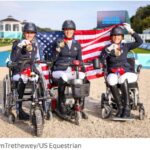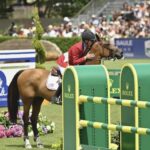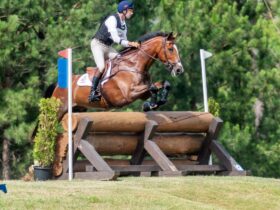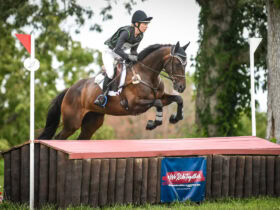Welcome to part two(a) of our three-part series on Farm Stand—the riders’ sanctuary tucked away at the water’s edge of the Palm Beach International Equestrian Center (PBIEC) in Wellington, Florida.
Farm Stand’s delicious food and decadent beauty products depend largely on the quality of their ingredients. Most of those ingredients come directly from Farm Stand’s own edible garden, which is designed, curated, and maintained each year by the horticultural genius of Heidi Hoover.
Meet Heidi Hoover, Farm Stand’s Gardener Extraordinaire.
EQuine AMerica: Hello, Heidi! We’re excited to talk with you about Farm Stand’s garden, but first, can you tell us a little about yourself?

Heidi Hoover: Hi, I’m Heidi Hoover and I own a company called The Edible Garden, which I started about six years ago. Becky Gochman called me one day and said she had this idea to do a farm stand at the horse show and a garden on her property. I was on board with all of it. Her ideas were wonderful. It wasn’t about making money, it was just about her wanting people to understand that you can do this: you can eat healthily, you can grow vegetables at your farm.
I was so in love with all of her ideas! I was so excited to get teamed up with her. It’s been great… It’s evolved over the years and now Farm Stand has a lot of great products. They make a lot of different things, and it’s just really fun to be a part of it all.
Kristy Strait: We’re so grateful for Heidi!
Have you been with Farm Stand for their whole four years?
Yes. I’ve been with them from the beginning. We planned the garden that is now at the farm in Grand Prix Village. I was there with Becky for the walk-through of the property, and she told me her ideas, and we met with a landscape architect and designed the garden.
What have you planted? Everything from herbs and vegetables to flowers and fruit trees?
The idea was always to make it an edible yard. We started out with a lot of fruit trees. We have bananas, papayas, and mangoes. We have some pomegranate, mulberries, citrus—a lot of different fruit trees. We do some vegetables, but we’ve turned more to doing flowers and herbs for Farm Stand products.
It sounds very tropical. We’re very tropical, even for Florida. Florida has several different zones, and Wellington is definitely in a tropical zone. It’s wonderful because we can grow so many tropical fruits here. We have so many different species of fruit trees that I think it’s a nice little garden to tour to learn what they look like and what’s possible to grow here.
How do you decide what to plant? Does the Farm Stand team request what they need for their beauty products and the menu? Or, do you inform them on will grow best in the zone that you’re in, and then they plan around that?
It’s basically going off of Kristy’s list of what she needs for Farm Stand, and then there’s always a few things I add in. Kristy and I go back and forth, and she’ll have suggestions and I’ll say, “Maybe this will grow better. Why don’t we try this?”

It’s a very symbiotic relationship. We sort of make our dream list and work our way backward from there, seeing what’s available and what will work. I love Heidi’s ideas—she’ll try things and the next thing you know we’ve plucked it from the garden and it’s an ingredient in one of our products. Or Tess will try something new in a soap batch, we fall in love, and then ask Heidi if we can grow it. The garden informs our products and our products inform the garden. So I guess they’re always talking, too!
Like last year, I don’t know how it came up, but I think I just had some seeds and I ended up planting a loofah vine. It was really fun to bring them into the shop. I swear every single person that picked one up was blown away it came from a vine. They all thought it came from the ocean. I’m like, “No, that’s a sponge!” But I would have thought the same thing!
I kept pulling up the video of us finding them in the vines. The vines have the most beautiful yellow flowers you’ve ever seen, and then you’ll find these huge green fruits tucked away in there—they’re so heavy! They kind of look like massive zucchini. Then they start to turn more yellow like a gourd, and after you harvest them and they dry out, they become completely lightweight. You peel the skin off of that and you have a loofa! So many stages of transformation!
I’m really delighted to hear that they were grown in Florida. I just imagined they had to come from some exotic rainforest somewhere.
I think they’re native to Asia. It’s funny, in south Florida our climate is more typical for growing similar to South Asia. A lot of people try to grow a lot of European vegetables and things, but our climate is actually more typical of Asia. A lot of the things that Tess grew up with living in the Philippines grow well here too because we’re very similar in our climate.
I was just going to ask whether Tess’s Filipino heritage ever informs what you plant. Definitely. I’ve learned a lot from her. I’ve learned a lot from all the girls that work at Farm Stand and what they would grow back home.
That reminds me of one day when I came over to the garden and thought, ‘Oh my God, is that Katuk!?’ It’s this amazing, nutty flavored, nutritious green native to Southeast Asia that hardly anyone here has heard of, but when I lived in Panama, we’d managed to get some of it and work it into the food forest we were growing. We made salads with it just about every night—that and a little Cranberry Hibiscus sprinkled in. Then I looked over, and next to it Heidi there was Cranberry Hibiscus growing. I couldn’t believe it! I never expected to see those two plants growing in a garden here in Wellington, and side-by-side!
The Katuk was actually from a field trip that Tess and all the girls and I took over to the west coast of Florida to visit the ECHO Garden Center. They do a lot of worldwide outreach teaching people how to plant in climates that are not very hospitable to growing. They had Moringa, Katuk, Chaya, Cranberry Hibiscus, etc. They’re not necessarily vegetables, just edible plants that will also grow here in Florida. That was a fun trip that we took out there, and we got a lot of the plants that are used for Farm Stand.
It’s interesting that you took a field trip because Tess was talking about how she took a field trip to upstate New York to learn more about making tea. When she said that, I thought, ‘Wow, that’s amazing that Becky is sending people places to learn these crafts.’ There are so many facets to Farm Stand, including getting you guys educated on what’s possible so you can bring that to the community here in Wellington. It’s very inspiring.
Is the garden close to the horses?
They’re not far. It’s fun to see these beautiful animals out there while I’m doing my gardening. It must be very peaceful. It’s wonderful. I love going out there.
On the stable side of the property, there’s a large open field that I think was originally planned to be a jumping field, but it’s a little bit too wet and they’ve never used it. This past season, Becky asked, “Why don’t we do a field of wildflowers where we can just let it grow and it’s more natural and better for the environment?” I spoke with the landscaper and they said, “Oh no, you’ll never be able to do it.” I just thought, ‘You know what, let’s give it a try.’ I came up with a plan, we ordered the wildflower seeds, and they came up beautifully.

I remember we were holding our breath. You said, “I don’t know if this is going to work. Becky has this vision that’s so beautiful, but I have no idea if we can pull it off!”
The landscaper thought we were crazy, and that’s what’s so great about Becky; she has these visions, and she pushes you outside the box. I didn’t know if it was going to work, but I had a feeling—and it worked. It was so exciting, and the garden was really, really pretty.
It’s typical of Florida to have squared-off hedges and manicured lawns, but I think it’s nice to open people up to other possibilities like doing wildflowers instead of grass. I think that’s a really interesting part about this project, and about Farm Stand as a whole. It’s all about showing the community something—showing what’s possible. Absolutely, yes.
It was right beside the riding arena and people could see the wildflowers when they rode by on their way to the show. I had a lot of people comment about it.
Someone mentioned something about your vision for roadside wildflowers…
Well, that’s actually Becky’s idea, too. The Florida Wildflower Foundation gives grants for certain projects and we’re going to see if we can get them on board for doing something in town, maybe on some of the public areas along the roadways.
It sounds like it’s ever-evolving, but do you have goals lined up for this season or next?
I think, for now, it is ever-evolving, but I think wildflowers is another focus for next season and expanding it out into the community. We love having the wildflowers on the property, but like you were saying, we want to show other people in the community that they can do this, too. I think that’s something that we’re really excited about for next season. That’s next on the list!
Want to know more about Farm Stand? Read this.
As an equestrian media outlet focused entirely on American horse sport, EQuine AMerica showcases the USA’s equestrian talent (both two-legged and four) in the disciplines of para dressage, dressage, hunters, jumpers, and eventing. We support and promote our nation’s fantastic equine events, products, services, artists, authors, science/tech, philanthropy, and nonprofits through our online magazine and social media platforms. Our mission is to offer you interesting/inspiring short and long-form content in a format that’s beautiful, readable, and relatable.





















SOCIAL